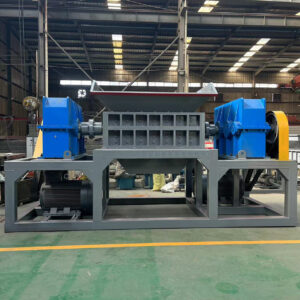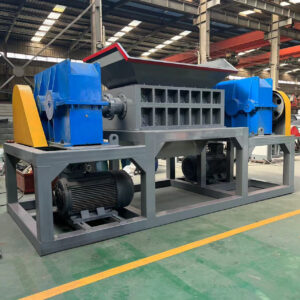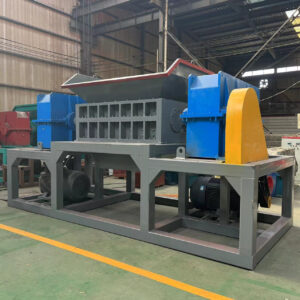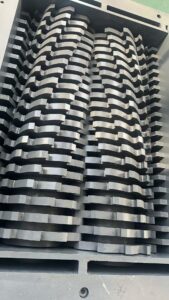In today’s rapidly evolving industrial landscape, efficient waste management and material processing are more critical than ever. One piece of equipment that has gained tremendous popularity across various sectors is the double shaft shredder machine. Known for its powerful shredding capabilities, versatility, and robust construction, the double shaft shredder plays a pivotal role in recycling, manufacturing, and waste reduction.
In this article, we’ll explore what a double shaft shredder machine is, how it works, its key features, benefits, and typical applications. Whether you’re considering investing in one for your facility or just curious about industrial shredding technology, this comprehensive guide will help you understand why the double shaft shredder is a leading choice worldwide.
What is a Double Shaft Shredder Machine?

A double shaft shredder (also known as a twin shaft shredder or dual shaft shredder) is a mechanical device designed to shred or cut a wide range of materials into smaller pieces. It features two parallel rotating shafts equipped with multiple blades or cutters that interlock and rotate towards each other. This configuration enables it to handle tough materials effectively by tearing, cutting, and crushing them simultaneously.
Unlike single-shaft shredders, which primarily cut materials against a fixed blade, double shaft shredders provide a more aggressive shearing action due to the opposing rotation of the two shafts. This design is especially effective for processing bulky or irregularly shaped materials.
How Does a Double Shaft Shredder Work?
The core working principle of a double shaft shredder lies in its twin shafts, each mounted with robust cutting blades. When powered on, the shafts rotate in opposite directions, pulling materials into the shredding chamber.
Key points about operation:

-
Material Feeding: The material is fed into the shredder’s hopper or feed opening. The rotating blades grip the material and begin tearing it apart.
-
Cutting & Tearing: The interlocking blades cut and tear the material. Because the shafts rotate oppositely, they create a strong shear force that efficiently breaks down materials.
-
Output Size: The shredded material size depends on the blade configuration and the gap between the shafts. Some machines also feature screens below the shafts to control particle size.
-
Discharge: Once shredded, the smaller pieces fall through the bottom or are conveyed to the next processing stage.
Key Components of a Double Shaft Shredder
Understanding the main parts helps appreciate why double shaft shredders are so effective.

-
Twin Shafts with Blades: Usually made of high-strength steel, the blades are the heart of the shredder. Their design, number, and arrangement determine shredding efficiency.
-
Feed Hopper: The inlet where raw material is loaded.
-
Drive System: Typically powered by electric motors coupled with planetary or gear reducers for torque multiplication.
-
Frame/Body: A heavy-duty frame, often constructed from thick steel plates or reinforced tubing, provides stability and houses the components.
-
Control System: Modern shredders use PLC-based systems for control, monitoring, and safety features.
-
Safety Mechanisms: Emergency stops, overload protection, and reverse rotation functions to clear jams.
Advantages of Double Shaft Shredder Machines
Double shaft shredders are favored in industrial environments for numerous reasons:
1. Versatility

They can shred a wide variety of materials including:
-
Plastics (e.g., bottles, films, pipes)
-
Wood (e.g., pallets, furniture scraps)
-
Metal scraps (light gauge steel, aluminum)
-
Rubber (tires, conveyor belts)
-
Paper, cardboard, and textile waste
-
Electronic waste (cables, circuit boards)
This versatility makes them indispensable in recycling plants, manufacturing facilities, and waste management companies.
2. High Torque and Power
Thanks to the twin shaft design and powerful motors, these shredders generate high torque ideal for processing tough and bulky materials. They can handle irregular shapes and large sizes efficiently.
3. Low Speed, High Torque Operation
Operating at low speeds (typically 10–30 RPM), double shaft shredders minimize noise, dust, and heat generation. This low-speed, high-torque mode also reduces wear and tear on blades and motors.
4. Easy Maintenance and Blade Replacement
The modular blade design allows easy inspection, maintenance, and replacement. Some models come with hydraulic blade adjustment and quick-release mechanisms to reduce downtime.
5. Effective Anti-Jamming and Overload Protection
Most double shaft shredders feature overload protection systems and reverse rotation functions to clear blockages automatically, enhancing operational reliability.
6. Customizable Output Size
By changing blade types, shaft gaps, or adding screens, users can customize the shredded output size to meet specific processing needs.
Typical Applications of Double Shaft Shredders
1. Recycling Industry
Double shaft shredders are extensively used to process:
-
Plastic bottles and containers into flakes for recycling
-
Scrap tires for rubber granules
-
Electronic waste to separate valuable metals and plastics
-
Wood waste into chips for biomass or mulch
2. Waste Management
Municipal and industrial waste shredding reduces landfill volume, facilitates sorting, and improves waste-to-energy conversion.
3. Manufacturing and Industrial Processes
Processing scrap materials such as metal sheets, conveyor belts, or defective products for reuse or disposal.
4. Chemical and Pharmaceutical
Shredding packaging materials or solid waste before further treatment.
Choosing the Right Double Shaft Shredder: Key Considerations
When selecting a double shaft shredder for your operation, consider:
-
Material Type: Hardness, abrasiveness, and moisture content affect blade choice and motor power.
-
Feed Size: Maximum size of raw materials to determine feed hopper and shaft dimensions.
-
Output Size Requirements: Needed final particle size for the shredded product.
-
Capacity: Desired throughput (tons per hour) to size the machine accordingly.
-
Power Supply: Available voltage and phase to match motor specifications.
-
Space and Installation: Machine footprint and installation requirements.
-
Maintenance Needs: Ease of access for blade replacement and servicing.
Conclusion
The double shaft shredder machine is a powerful, versatile, and efficient solution for industrial shredding needs. Its robust design and effective cutting mechanism make it ideal for handling a wide range of materials across various industries. Whether for recycling plastics, processing waste, or preparing materials for reuse, double shaft shredders help businesses improve efficiency, reduce waste, and lower costs.
If you are considering adding a shredder to your operation, understanding the features and benefits of the double shaft shredder can help you make an informed decision. Always choose a reliable manufacturer that offers quality components, customization, and strong after-sales support.
